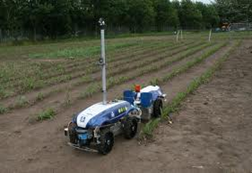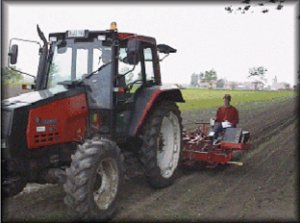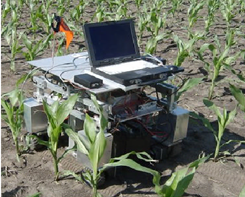
Title: An Overview of Agricultural Robots
Authors: P.Koteswara Karthik & P.Ravi Chandra, 1st Year BTech, Mechanical Engineering
College: Prakasam Engineering College, Kandukur
ABSTRACT
Current methods for off-road navigation using vehicle and terrain models to predict future vehicle response are limited by the accuracy of the models they use and can suffer if the world is unknown or if conditions change and the models become inaccurate .In this paper, an adaptive approach is presented that closes the loop around the vehicle predictions. This approach is applied to an autonomous vehicle known as field robots used in agriculture.
Agricultural Robotics is the logical proliferation of automation technology into biosystems such as agriculture, forestry, green house, horticulture etc. Presently a number of researches are being done to increase their applications. Some of the scientist contributions are mobile robot, flying robot, forester robot, Demeter which are exclusively used for agriculture. A brief discussion is being done about the types of robots which increase the accuracy and precision of the agriculture.
Experiments are being done on newly proposed world’s smallest, weightless robot for using them as scouts in fields. Even in developing countries, such as India and Brazil, farmers are interested in using robots to tend fields of crops, pick fruit, or even maintain animal. At present time, agriculture robots must have human interaction in order to compensate for programming complexity issues.
INTRODUCTION
The idea of applying robotics technology in agriculture is very new. In agriculture, the opportunities for robot-enhanced productivity are immense – and the robots are appearing on farms in various guises and in increasing numbers. We can expect the robots performing agricultural operations autonomously such as spraying and mechanical weed control, fruit picking, watching the farms day & night for an effective report, allowing farmers to reduce the environmental impact, increase precision and efficiency, and manage individual plants in novel ways.
The applications of instrumental robotics are spreading every day to cover further domains, as the opportunity of replacing human operators provides effective solutions with return on investment. This is specially important when the duties, that need be performed, are potentially harmful for the safety or the health of the workers, or when more conservative issues are granted by robotics. Heavy chemicals or drugs dispensers, manure or fertilizers spreaders, etc. are activities more and more concerned by the deployment of unmanned options.
How do conventional techniques differ from an automized one?
Conventional techniques depend on human power for lifting, dragging, weed control, fruit picking. Humans are prone to work in hazardous environment while spraying chemicals and pesticides. The tractors compact the soil, as they are larger in weight. They cannot move in terrain conditions. These methods cannot identify the crop and soil in close proximity. In the case of automated agriculture (which uses field robots) is exemplified from above problems. Robots can work restlessly in all environments; all you have to do is set a program to perform the desired activities.
Although, large sized wheels are required in muddy soils, robots small sized wheels perform well. Robot scouts are employed to get detailed information about the crop such as the presence of diseases, weeds, insect infestations and other stress conditions. The lightweight of the robots is a major advantage, since they do not compact the soil as larger machinery does. Robo will wander on fields to take care for plants.
CULTURE:
- Demeter (used for harvesting).
- Robot for weed control.
- Forester robot.
- Robot in horticulture.
- Fruit picking robot.
- Micro-flying robot.
The robots mentioned here come under are Field robots and some are Mobile robots.Field robots work with respect to environment and medium. They change themselves according to the required condition. Mobile robots are those which posses mobility with respect a medium. The entire system moves with respect to environment.
GOALS AND PURPOSES:
- To provide access to hazard environment.
- Reduced operating costs due to lower cost of employing robots.
- Higher overall availability of robot workers (no lunch breaks or vacations) and many more.
- To complete large amount of work in less time.
OPERATION OF AGRICULTURAL ROBOTS:
DEMETER: Robot farmer:
“Labour requirements to grow and harvest the crops must be reduced through automation”. The main area of application of robots in agriculture is at the harvesting stage. Demeter is a robot that can cut crops like wheat and alfalfa. It is named for the Roman goddess of agriculture. Although, it may look like a normal harvester, Demeter can drive by itself without any human supervision. Unfortunately, people get tired and bored, and their productivity goes down. With a robotic harvester, however, it never gets tired and can operate 24 hours a day.
Demeter has cameras on it that can detect the difference between the crop that has been cut and crop that hasn’t. This information tells it where to drive, where to put its cutter head, and when it has come to the end of a crop row so it can turn around ,Demeter has a cruise control function. An operator can ride along with it. Demeter can drive, steer, and control the cutter head while the operator can focus on other tasks. The Demeter robot can also be driven by remote control. Or, Demeter can be taught a path and then follow that path using its on board sensors and computer control systems. It can follow the path with an accuracy of up to 3 centimeters.
The Demeter system strives to provide three levels of automation to harvesters, and eventually to tractors and combines. First, a “cruise control” feature, which will automatically steer, drive and control the harvesting header, will be provided to harvester operators. This feature will allow the operator to focus on other in-cab controls and harvest conditions, and to better handle contingency situations. Secondly, a “drone” feature will be provided, allowing one operator to remotely control several harvesters.
Thirdly, a fully autonomous machine will be developed that will allow a harvester to completely harvest a field with no human supervision.
Benefits: The first two levels of the Demeter system allow fewer, lesser-skilled operators to provide performance equal to or better than the current harvester performance on the average farm. At the final level of automation, performance will be maintained with no human supervision.
Weed Controller:
Farm working usually involves a harsh environment such as limited work space and soft, unstable or uneven surfaces. The development of novel weeding technologies that can reduce manual effort by 50% to 100% in organically grown sugar beets and vegetable and herbicide usage by 75-100% in high value crops. They can also be used in plants, which are widely separated. This techniques use robots in the field, to replace operators on steerage hoes.
A four-wheel-drive weed-seeking robot was developed by the Danish Farm Research Authority. The task of the weed-removing device is to remove or destroy the weed. Crops that are grown in rows can be weeded by running a hoe between the crop rows. Labour consuming systems that involve an operator driving the tractor, with a second person controlling the hoe. An intelligent hoe uses vision systems to identify the rows of crops, and steer itself accurately between them, considerably reducing the need for herbicides Weed identification is based on colour photography. The equipped robot helps production of weed maps identifying plant.
Vision-guided intra-row cultivator, able to perform mechanical weed control within the row of sugar beets plants, thus totally eliminating the need for chemical weed control. An Autonomous mobile robot for agriculture operations is driven by its two wheels at the back, each independently driven with a DC-servo motor equipped with encoder, tachometer and brakes. The steering mechanism is an Ackerman-steering controlled with a DC-servo-motor. The electrical power is provided by batteries or by a fuel-driven generator the systems looks at a certain environment containing several plants. Knowing that the sugar beet plants are sown in rows and with a certain constant distance among them, it is possible to classify the sugar plant from the weed plant. It could be saving farmers money right from the starting. For safe night work, field obstacles can be programmed into each field map so the tractor can automatically take avoidance action.
Robots used in forest:
Treebot:
A fearless mobile robot is helping scientists monitor environmental changes in forests. The hi-tech Tarzan of the robot world, nicknamed Treebot, is the first of its kind to combine networked sensors, a web cam, and a wireless net link. It is solar-powered and moves up and down special cables to take samples and measurements for vital analysis.
Treebot has been developed by scientists at the US Center for Embedded Network Sensing in California. Pinpoint precision Programmed with open-source computercode, Linux, the Treebot is a vital addition to researchers’ environmental monitoring kit, according to one of the project leaders, Professor William Kaiser. “One of the objectives is to make use of distributed sensors to acquire information about the environment,” he said.
“It is very important in the biology community to understand the interaction between the atmosphere and the forest environment.” Understanding subtle changes in light, humidity, and carbon dioxide levels give scientists crucial indications and predictions about environmental change. But 90% of all interaction between the environment and atmospheric conditions happens high up in the forest canopy, and it is a challenge taking detailed measurements and monitoring conditions over a period of time. The Treebot, which in scientific terms is a node in a Networked Info mechanical System(Nims), helps by being stealthy enough to travel through the forest canopy along specially constructed cabling, night and day.
Forester robot:
This is a special type of robot used for cutting up of wood, tending trees, and pruning of X- mas tree and for harvesting pulp and hard wood and in the forests. It employs a special jaws and axes for chopping the branch. The forester robot with six legged moves in the forest.
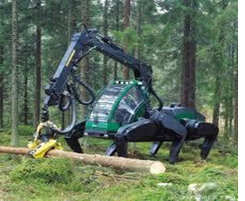
Fruit picking robot:
The principles of fruit picking robots have been developed since the early 1980’s. These principles have opened up new approaches to the harvesting of crops. However, to fully develop the fruit picking robotics technology, contributions from high-tech industry, agricultural commodity groups and farm equipment manufacturers must be sought.
To start with, the fruit picking robots need to pick ripe fruit without damaging the branches or leaves of the tree. Mobility is a priority, and the robots must be able to access all areas of the tree being harvested. It goes then without saying that the robots must be intelligent, and have a human-like interaction with their surroundings through senses of touch, sight, and image processing. The fundamental blocks of these robots are shown in the figure

The robot can distinguish between fruit and leaves by using video image capturing. The camera is mounted on the robot arm, and the colours detected are compared with properties stored in memory. If a match is obtained, the fruit is picked. If fruit is hidden by leaves, an air jet can be used to blow leaves out the way so a clearer view and access can be obtain.
The robot arm itself is coated in rubber to minimize any damage to the tree. It has 5degrees of freedom, allowing it to move, in, out, up, down, and in cylindrical and spherical motion patterns. The pressure applied to the fruit is sufficient for removal from the tree, but not enough to crush the fruit. This is accomplished by a feedback process from the gripper mechanism, which is driven by motors, hydraulics, or a pneumatic system. The shape of the gripper depends on the fruit being picked, as some fruits, such as plums, crush very easily, while others, like oranges are not so susceptible to bruising.
The robots should have access to all areas of the orchard in order to reach all of the fruit. Significant work has been done in the production of end effectors in France. They are capable of harvesting apples and citrus.The limitations of these systems were mainly in their inability of picking the fruits, which were covered by the branches. This resulted in robots being in capable of harvesting more than 75%.
FUTURE SCOPE:
Flying micro robot: (a newly proposed robot): Scientists from around the world are reverse-engineering the mechanics of insects as they design midget robots to scout battlefields, search for victims trapped in rubble and record images in agricultural fields.
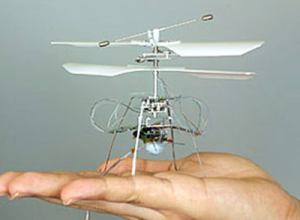
The world’s smallest micro robot was placed in the geniuses book of world record. The experiments have been conducted so as to know the fields of operation.. The micro robot consists of propeller by which it can fly to heights these features include the ability to zero in and land precisely on a potato chip and then flap their wings to buzz off with blazing speed. It is expected that it can be used in agriculture for the control of weed and insects.
ADVANTAGES:
- The Robo does not get sick or tired and does not need time off.
- It can operate with closer tolerances (so every round is at full field capacity), Fewer errors and at higher speeds
- Because machines can be made lighter and cheaper if the driver’s seat, controls and cab can be eliminated.
- It can be used in various fields like agriculture, medicine, mining, and space research .
- It can be sent to another planet to study their environmental conditions.
- The machines could easily work around trees, rocks, ponds and other obstacles.
- Small suburban fields could be worked almost as efficiently as large tracts of land.
DISADVANTAGES:
- One of the key disadvantages of driverless machines for agriculture is liability.
- Access to the technology.
- Not currently scale neutral.
- Better sensors would help. Improved scouting programs would be essential. Nevertheless, a periodic human presence in the field is likely to be necessary for the near future.
- Robots could change the culture /emotional appeal of agriculture.
- Energy issues costly.
CONCLUSION:
In agriculture, the opportunities for robot-enhanced productivity are immense – and the robots are appearing on farms in various guises and in increasing numbers. The other problems associated with autonomous farm equipment can probably be overcome with technology. This equipment may be in our future, but there are important reasons for thinking that it may not be just replacing the human driver with a computer. It may mean a rethinking of how crop production is done. Crop production may be done better and cheaper with a swarm of small machines than with a few large ones.
One of the advantages of the smaller machines is that they may be more acceptable to the non-farm community. The jobs in agriculture are a drag, dangerous, require intelligence and quick, though highly repetitive decisions hence robots can be rightly substituted with human operator. The higher quality products can be sensed by machines (colour, firmness, weight, density, ripeness, size, shape) accurately. Robots can improve the quality of our lives but there are downsides.
REFERENCES:
- IEEE ROBOTICS &AUTOMATION SOCIETY, SUB COMMITTEE FOR ROBOTICS AND AUTOMATION.
- ROBOTICS TECHNOLOGY AND AUTOMATION BY S R DEB.
- INDUSTRIAL ROBOTICS BY MIKELL P. GROOVER.
- EPSON MICRO FIYING ROBOT.

